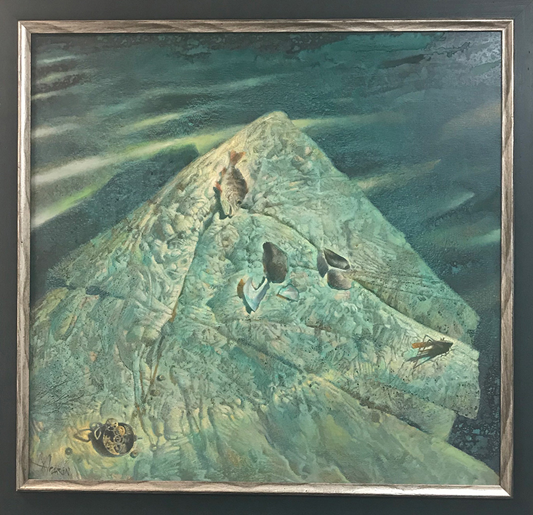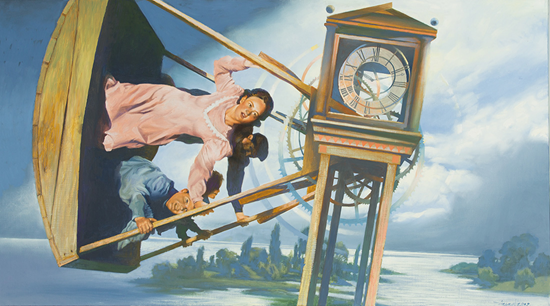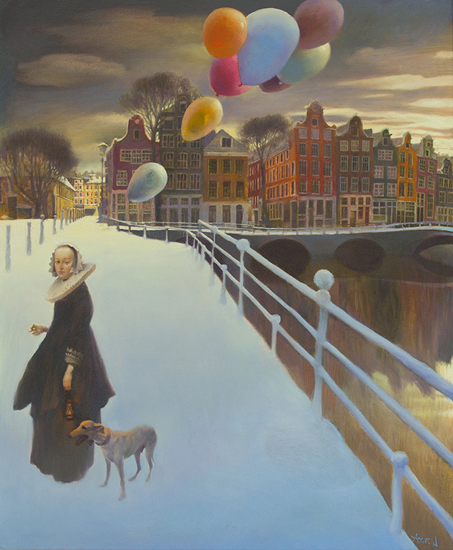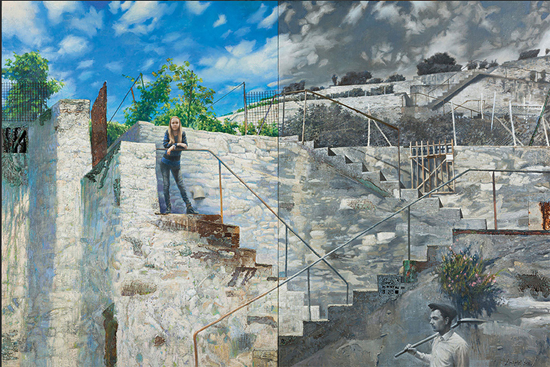
Den großen Meistern der Gegenwart wird abverlangt, die Perfektion ihrer Vorgänger zu erreichen und noch etwas hinzuzufügen. Sergei Aparin gelingt das. Jedes Bild eine eigene Welt. Reales vermischt sich mit Mystischem. Eine Einladung zum Eintauchen, Verweilen und Nachdenken, die man gerne annimmt. Über jedes Werk könnte man einen langen kunsthistorisch/philosophischen Aufsatz verfassen. Im Rahmen einer Katalogeinleitung ist der Umfang auf einige Häppchen begrenzt und der Betrachter zum „Weiteressen“ eingeladen.
Vielen seiner Ölgemälde sind bildhauerische Elemente hinzugefügt, die die Werke ergänzen und bereichern. Teilweise verweisen sie auf eine Welt hinter dem Bild und verleihen diesem eine optische jedoch zugleich auch philosophische Tiefe wie eine Aufforderung zum kritischen Hinterfragen und Nachdenken weg vom Oberflächlichen.
Bei anderen Werken wiederum steht, obwohl als Ölgemälde konzipiert, die Skulptur im Vordergrund. In der Konzeption seiner auf diese Art gestalteten italienischen Häuserfronten wehen Wäschestücke im Wind. Die Atmosphäre des Werkes ist auf eine Weise lebendig und einladend, dass man den Titel des Bildes „Cappuccino“ fast riechen und schmecken kann, obwohl das titelgebende Element winzig klein, kaum auffindbar im Restaurant des Erdgeschosses des Gebäude steht. Romantische Erinnerungen an schöne Urlaubsstunden in einer italienischen Stadt sind damit ins eigene Wohnzimmer projiziert.
Sein Bild „Wind“ hat eine Dynamik, die den starken Wind die Segel der Schiffe den Rahmen durchbrechen lässt und diesen naturgetreu ballonartig aufbläst.
Im Ölgemälde „Aquarium“ verschwimmen und überlagern sich unten und oben, farbig und schwarz-weiß, Traum und reale Welt. Hat das Leben vor der Geburt oder nach dem Tod Berührungen mit unserem irdischen Dasein? Sind wir durch uns Unbekanntes geprägt oder beeinflusst? Oder sehen wir nur dynamische Fische in einer schönen Unterwasserwelt?
In seinen beiden Winterbildern ist den Bäumen Humanes eingehaucht. Schöne Winterlandschaften werden dabei nur bei genauem Hinsehen aus der Nähe zu mystischen Lebewesen. Eine Aufforderung zum genauen Hinsehen? Ein Hinweis für die Oberflächlichkeit moderner Gesellschaften? Liebe zur Natur? Ein Wink für den Menschen als Bestandteil und nicht Beherrscher der Natur?
Im Bild „Die Treppe“ werden, Öl, Metall und Kupfer auf Holz zu einem Bild komponiert, das einen über die Beziehung der Generationen nachdenken lässt. Im unteren rechten Teil im schwarz-weißen Schatten positioniert ein Mann mit Schatten als Repräsentant der alten Generation. Links oben im farbigen Bereich des Bildes ein junges Mädchen thronend. Sehr entspannt, vielleicht sogar ignorant auf den Errungenschaften der Eltern ruhend?
Aparins Werk „Das neue Licht“ reicht in Dichte, Komplexität und Ideenreichtum an Salvador Dalis berühmtestes Werk „Die zerrinnende Zeit“ heran. Die Assoziationsmöglichkeiten sind zu reichhaltig, um eine einzelne eigene Interpretation vorgeben oder vorschlagen zu können. Zeit, Vergänglichkeit, Freiheit, Hoffnung, Verletzung, Dummheit sind tiefgründig und surrealistisch in Öl, Kupfer, Bronze und Eisen auf Holz thematisiert.
Warum ziehen im Ölbild „Schatten“ drei schematisch dargestellte Vögel in den Schatten? Das Bild ist in der Lage die Atmosphäre eines großen Raumes zu ändern, zum Erstrahlen zu bringen. Ein schönes, ruhiges Naturbild – jedoch es bleibt die Frage nach der Reise der Vögel in die Schattenwelt.
Den großen Meistern der Gegenwart wird abverlangt, die Perfektion ihrer Vorgänger zu erreichen und noch etwas hinzuzufügen. Sergei Aparin gelingt das. Jedes Bild eine eigene Welt. Reales vermischt sich mit Mystischem. Eine Einladung zum Eintauchen, Verweilen und Nachdenken, die man gerne annimmt. Über jedes Werk könnte man einen langen kunsthistorisch/philosophischen Aufsatz verfassen. Im Rahmen einer Katalogeinleitung ist der Umfang auf einige Häppchen begrenzt und der Betrachter zum „Weiteressen“ eingeladen.
Vielen seiner Ölgemälde sind bildhauerische Elemente hinzugefügt, die die Werke ergänzen und bereichern. Teilweise verweisen sie auf eine Welt hinter dem Bild und verleihen diesem eine optische jedoch zugleich auch philosophische Tiefe wie eine Aufforderung zum kritischen Hinterfragen und Nachdenken weg vom Oberflächlichen.
Bei anderen Werken wiederum steht, obwohl als Ölgemälde konzipiert, die Skulptur im Vordergrund. In der Konzeption seiner auf diese Art gestalteten italienischen Häuserfronten wehen Wäschestücke im Wind. Die Atmosphäre des Werkes ist auf eine Weise lebendig und einladend, dass man den Titel des Bildes „Cappuccino“ fast riechen und schmecken kann, obwohl das titelgebende Element winzig klein, kaum auffindbar im Restaurant des Erdgeschosses des Gebäude steht. Romantische Erinnerungen an schöne Urlaubsstunden in einer italienischen Stadt sind damit ins eigene Wohnzimmer projiziert.
Sein Bild „Wind“ hat eine Dynamik, die den starken Wind die Segel der Schiffe den Rahmen durchbrechen lässt und diesen naturgetreu ballonartig aufbläst.
Im Ölgemälde „Aquarium“ verschwimmen und überlagern sich unten und oben, farbig und schwarz-weiß, Traum und reale Welt. Hat das Leben vor der Geburt oder nach dem Tod Berührungen mit unserem irdischen Dasein? Sind wir durch uns Unbekanntes geprägt oder beeinflusst? Oder sehen wir nur dynamische Fische in einer schönen Unterwasserwelt?
In seinen beiden Winterbildern ist den Bäumen Humanes eingehaucht. Schöne Winterlandschaften werden dabei nur bei genauem Hinsehen aus der Nähe zu mystischen Lebewesen. Eine Aufforderung zum genauen Hinsehen? Ein Hinweis für die Oberflächlichkeit moderner Gesellschaften? Liebe zur Natur? Ein Wink für den Menschen als Bestandteil und nicht Beherrscher der Natur?
Im Bild „Die Treppe“ werden, Öl, Metall und Kupfer auf Holz zu einem Bild komponiert, das einen über die Beziehung der Generationen nachdenken lässt. Im unteren rechten Teil im schwarz-weißen Schatten positioniert ein Mann mit Schatten als Repräsentant der alten Generation. Links oben im farbigen Bereich des Bildes ein junges Mädchen thronend. Sehr entspannt, vielleicht sogar ignorant auf den Errungenschaften der Eltern ruhend?
Aparins Werk „Das neue Licht“ reicht in Dichte, Komplexität und Ideenreichtum an Salvador Dalis berühmtestes Werk „Die zerrinnende Zeit“ heran. Die Assoziationsmöglichkeiten sind zu reichhaltig, um eine einzelne eigene Interpretation vorgeben oder vorschlagen zu können. Zeit, Vergänglichkeit, Freiheit, Hoffnung, Verletzung, Dummheit sind tiefgründig und surrealistisch in Öl, Kupfer, Bronze und Eisen auf Holz thematisiert.
Warum ziehen im Ölbild „Schatten“ drei schematisch dargestellte Vögel in den Schatten? Das Bild ist in der Lage die Atmosphäre eines großen Raumes zu ändern, zum Erstrahlen zu bringen. Ein schönes, ruhiges Naturbild – jedoch es bleibt die Frage nach der Reise der Vögel in die Schattenwelt.














